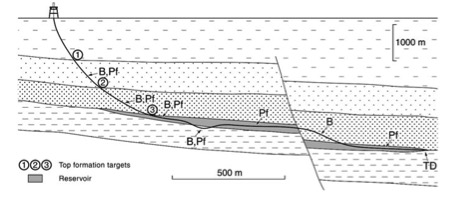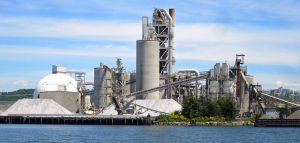Biosteering is the technical term used to describe the use of real-time biostratigraphic data during the drilling of a borehole, to control the position of the drill bit and drill string within predefined parameters. For this to be effective, the occurrence / absence, abundances and ratios of different microfossil groups and species is used. Biosteering requires the presence of an experienced palynologist, micropalaeontologist or nannopalaeontologist on the rig to constantly monitor the microfossils, as well as environmental indicators derived from palynofacies types, to ensure the correct formation is being drilled.
Before biosteering is used on a well, a pilot study is carried out on material from previously drilled wells in the area to prove the validity of the concept. Once completed, a biozonation scheme that defines the rock packages above and below the target formation can be constructed and used to constrain the position of the drill bit during drilling. Data from the new well is also incorporated into the scheme so that it is developed and enhanced for subsequent boreholes.
Once the target formation has been reached, biostratigraphy is used, usually in conjunction with Logging While Drilling (LWD) tools, to ensure that the drill bit stays within this target formation. Close liaison with the directional driller, wellsite geologist and other company personnel is required. Constant monitoring of samples is required whilst drilling is in progress to ensure that the drill bit stays within the target “envelope”, and so that any deviation from the prognosed track can be quickly rectified.

B = Biostratigraphy; Pf = Palynofacies ; TD = Terminal Depth
In the example above, conventional biostratigraphy determines the angle of build of the well path; biostratigraphy and palynofacies, or palynofacies analysis alone, keeps the drill on target (1, 2). The reservoir is reached (3) and intially the drill goes too low, which is recognised both in the biostratigraphy and palynofacies. The angle is changed and the reservoir regained. The drill then passes through a fault and biostratigraphy says we are too high, so the angle is dropped until palynofacies tells us we are back in the reservoir and then drilling continues to TD.
The primary aim of these biosteered horizontal and sub-horizontal wells is to expose the well bore to as much of the reservoir rock as possible and therefore enhance recovery from the potential reservoir. This allows reservoir penetration to be maximised by discriminating between non-pay above and below the reservoir and rectifying unpredicted exits from the reservoir due to sub-seismic faults. Biosteering enables high resolution reservoir subdivision into discrete, correlatable time-slices, using field-specific microfossil bioevents. This frequently provides greater precision than seismic and greater discrimination than wireline logs.
As a tool biosteering is relatively inexpensive when compared to using a larger suite of logging tools in the hole to determine stratigraphic position. It can often provide answers on stratigraphic position before the area is crossed by the LWD tool (which may be some way behind the bit).
Tony Loy has 30 years’ experience of being involved with biosteered wells, including all phases of the discipline from project initiation, through pilot studies, on-site application, refinement of schemes and final reporting and presentation. If you require any further information or help in putting together such a programme then please do not hesitate to contact Merlin.



